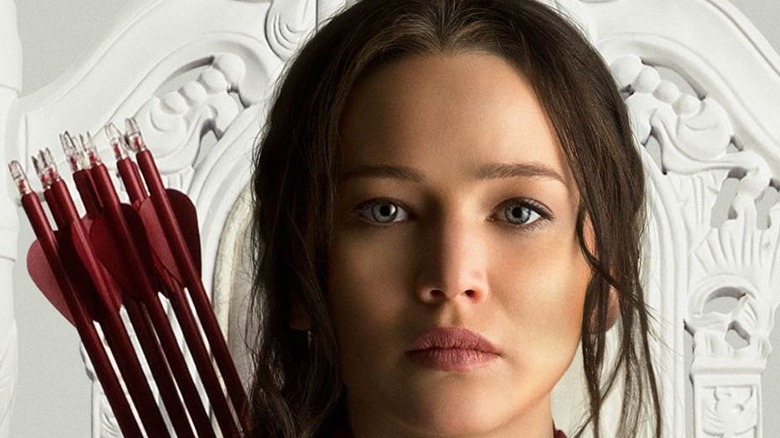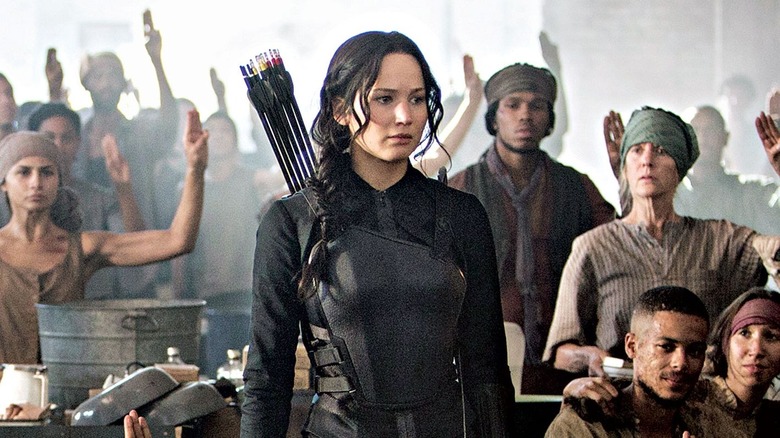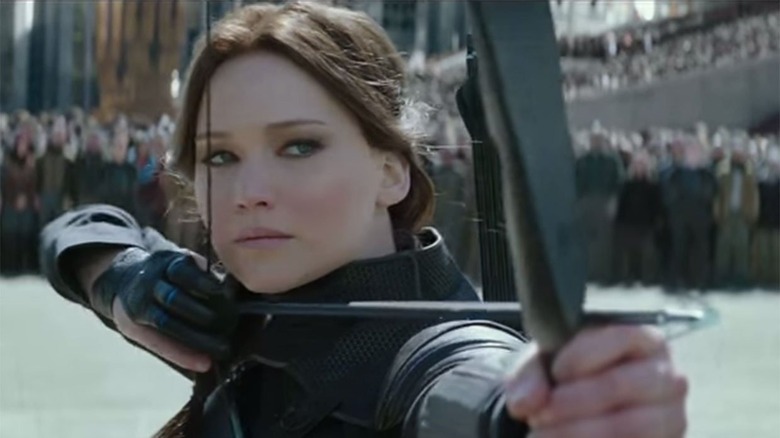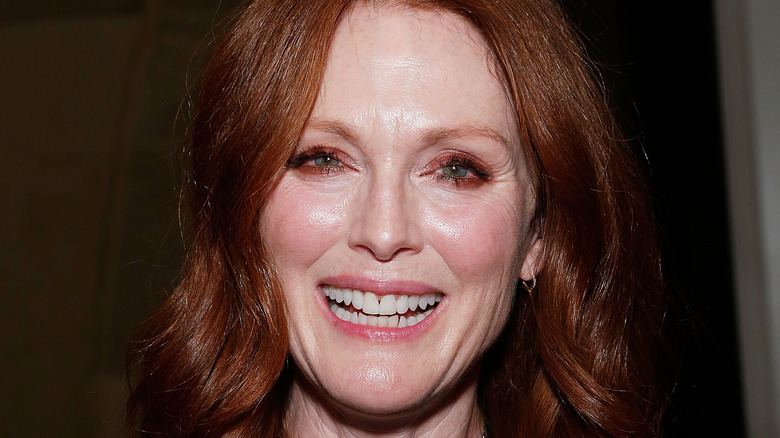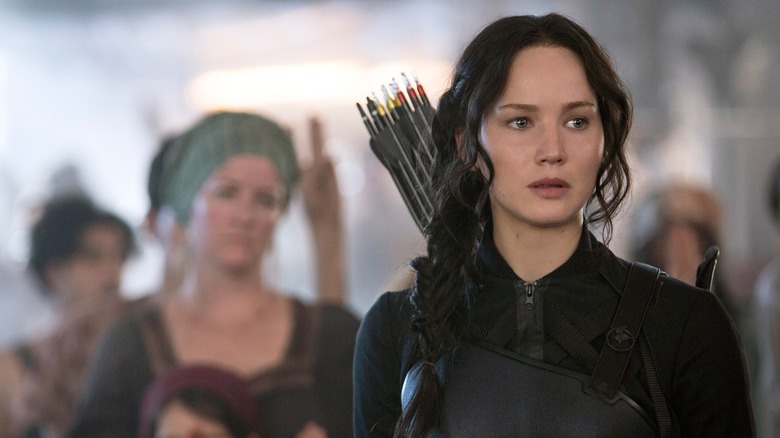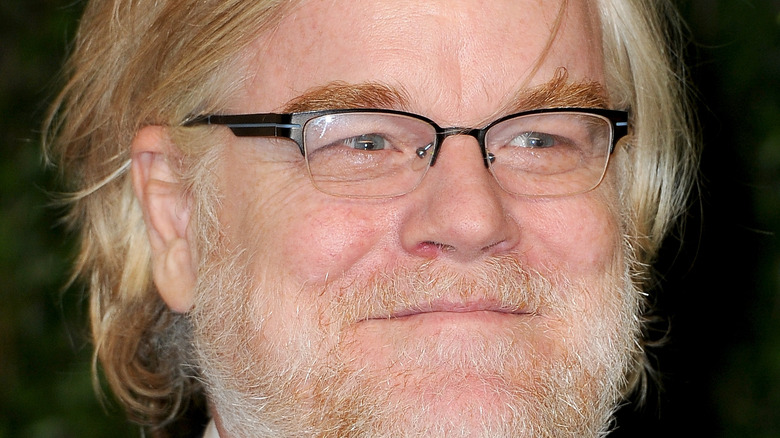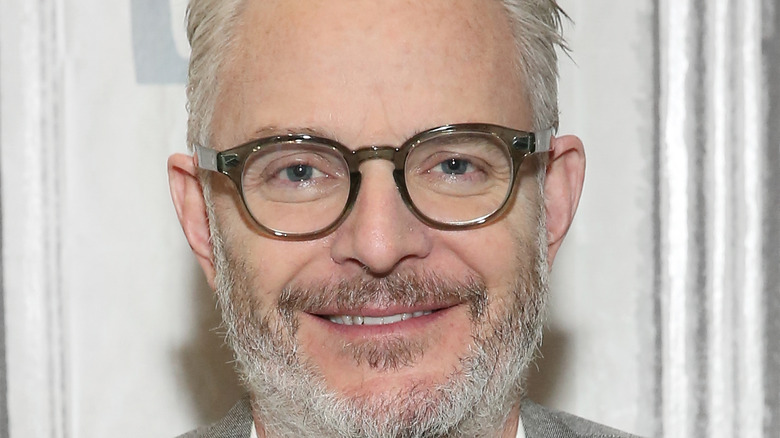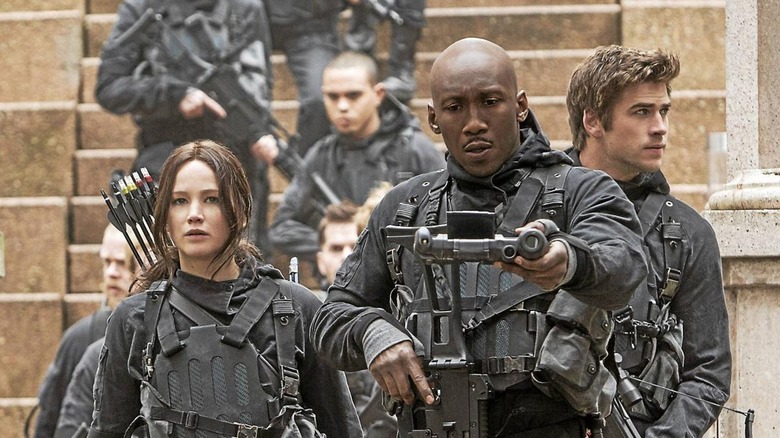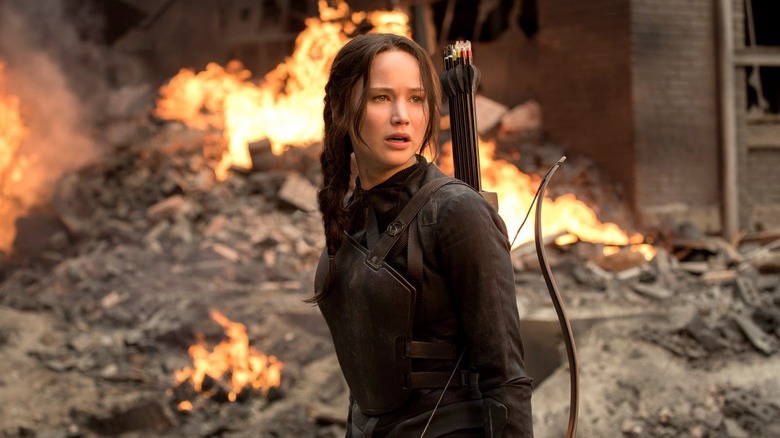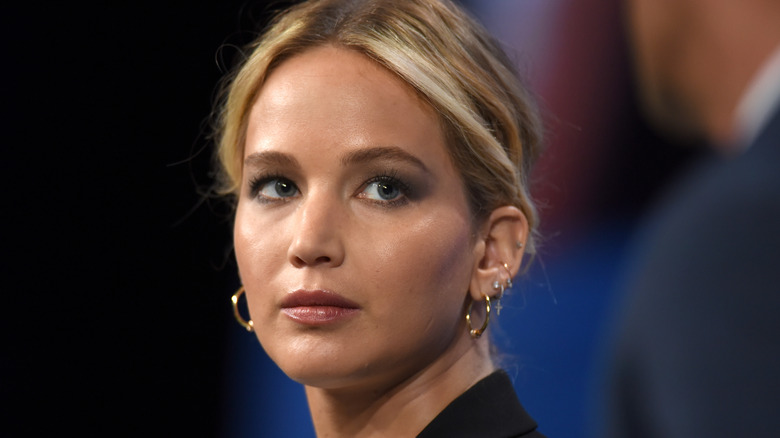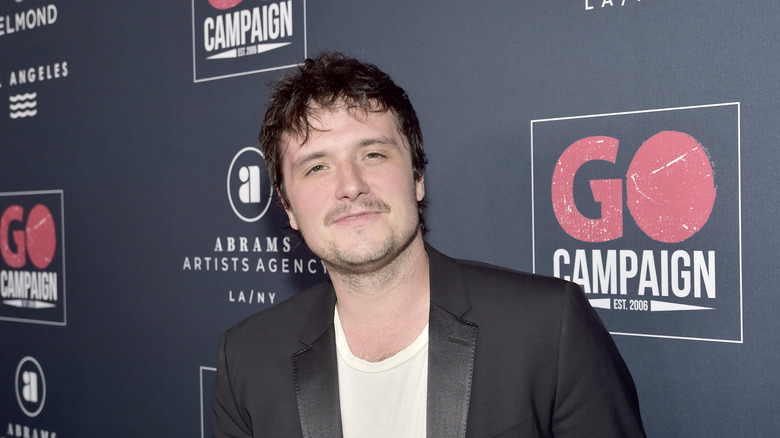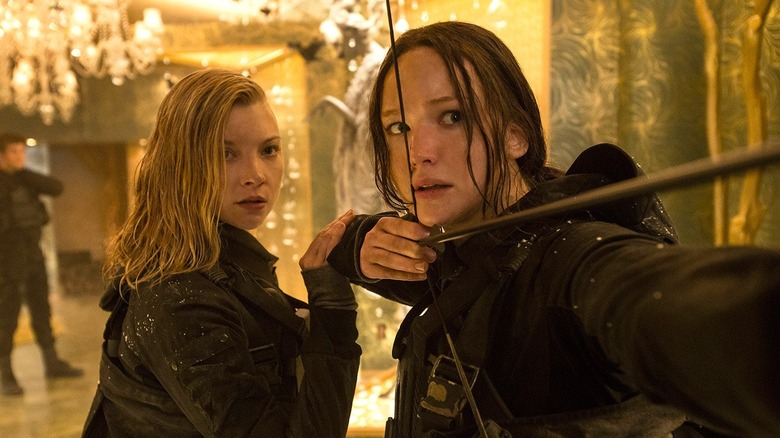What It Was Like Wrapping Up The Hunger Games Series
Everything must come to an end, even beloved film franchises.
For the film adaptations of the "Hunger Games" books, this was especially apparent. After all, there were only three books in the series to adapt, so when Jennifer Lawrence and the rest of the cast & crew began turning these texts into flesh-and-blood motion pictures, the finite nature was ingrained from the start. Nevertheless, it didn't make the emotionally overwhelming process of saying goodbye to close friends and allies any less difficult after four films in just as many years.
It wasn't just an abundance of goodbyes that defined wrapping up the "Hunger Games" franchise, however. "Mockingjay — Part 1" (released in 2014) and "Mockingjay — Part 2" (released in 2015) were two big blockbusters filmed consecutively, presenting a logistical nightmare. Add in the fact that series star Jennifer Lawrence had become arguably the hottest actor in the world, the earth-shattering news of Phillip Seymour Hoffman's passing ("Part 2," released posthumously, would mark the Oscar-winner's final film), domestic moviegoers' fluctuating opinions around the latest 3D fad and other factors, and the "Mockingjay" experience felt like the perfect storm of Hollywood unpredictability.
Regardless, the two films combined grossed more than $1.4 billion worldwide, proving that the odds were forever in their favor. Below, we take a look back at the unusual circumstances that surrounded the goodbye of "Games."
Deciding to split the book into two movies
Unsurprisingly, most trends in the world of YA novel movie adaptations can be traced back to the "Harry Potter" films. This was certainly true of the decision to split the final book into two movies, something first done with the last "Potter" book, "Harry Potter and the Deathly Hallows." Since then, "Twilight" and "Divergent" have also employed this strategy to varying degrees of success (Part 2 of "The Divergent Series: Allegiant" was ultimately cancelled) with their film franchises. So, it was only a matter of time before "Hunger Games" joined in.
Director Francis Lawrence, for his part, insisted that the advantage of telling "Mockingjay" over two movies was more than just a cash grab. "You know, we got some flack for splitting the movies," Lawrence explained. "I think they're two distinct stories, but really, that kind of evolution would be a much, much, much more difficult thing to do in the course of two hours, versus the course of two films."
Picking a director for "Mockingjay"
You can't make a movie without a director, and wrapping up the "Hunger Games" franchise meant selecting a filmmaker with action chops, an awareness of the source material, and the ability to maintain (and evolve) the look Gary Ross had created with the first film in the franchise.
Fortunately, they didn't have to look far. "Constantine" director Francis Lawrence had stepped in capably for the second film in the franchise (2013's "Catching Fire"), so the only question was whether he, like Ross, would be a one-and-done filmmaker in this saga. However, a year before "Catching Fire" hit theaters, Lawrence officially signed on to direct the sprawling "Mockingjay" production.
Going this route ensured that there would be a level of high consistency between the last three "Hunger Games" movies. In approaching the pair of series-ending blockbusters, Lawrence had a very specific approach as a filmmaker.
"One of the big pitches I made was that I didn't want to reinvent, I wanted to make the book. Everybody was with me on that; obviously so was (series writer) Suzanne Collins," he told the LA Times in 2015. "Luckily, Suzanne isn't a total stickler about everything; she's a great collaborator."
With Lawrence and his intent to "make the book" onboard to steer the "Mockingjay" ship, one of the biggest obstacles in bringing the book to the screen had been cleared.
Julianne Moore enters the "Mockingjay" cast
While YA movie adaptations like "Twilight" opt to go for lesser-known performers in their casts (at least, at the beginning when they're an uncertain commodity), "The Hunger Games" franchise showed an affinity for prestige talent from the very beginning. Legendary actors like Donald Sutherland and Woody Harrelson were featured as prominent characters in the first installment, while the sequel brought Oscar-winning character actor Phillip Seymour Hoffman into the fray.
The final "Hunger Games" films would feature the new character of Alma Coin, and producers knew it required a performer who could hold her own. Enter Julianne Moore, cast in the part in September 2013 and already renowned for her work in acclaimed projects like "Boogie Nights" and "The Kids Are All Right."
Lending even more prestige to the final "Hunger Games" movies, in between "Mockingjay" installments Moore snagged her first Academy Award win for the movie "Still Alice."
For her part, Moore was attracted to the "Games" movies because of her love for the source material. "They're books about war but with adolescent overtones," Moore explained to USA Today. "It's about, what is totalitarianism, what is revolution? How do people compromise, how do we repeat our mistakes? It's heartbreaking. I was really impressed by the books, so I'm delighted to be doing it."
Enduring the process of shooting movies back-to-back
Ask any filmmaker who's tackled shooting blockbusters back-to-back and they'll tell you it's a grueling process not for the faint of heart. Gore Verbinski found himself "wiped out" during the making of "Pirates of the Caribbean: At World's End"; making the "Hobbit" movies was a creatively challenging experience for Peter Jackson; Robert Zemeckis was known to film "Back to the Future Part III" during the day in Northern California, then fly to oversee editing and dubbing on "Back to the Future Part II" in Burbank, then fly back to the set the next morning. Filming the two "Mockingjay" movies back-to-back was no exception, as this lengthy creative endeavor took its toll on Francis Lawrence.
The biggest problem for him and other members of the production with being on the set for so long was missing loved ones. "We'd been away from home for a long time and so that was emotional," Lawrence said. "It was a relief to be done, but it was sad to be over."
Though the thought of seeing those loved ones again may have been inspiring, even the difficulties of crafting two blockbusters without a break couldn't shatter the bonds formed between members of the "Hunger Games" crew. In fact, Lawrence openly admits things got emotional on the last days of filming.
"I cried for sure," Lawrence recalled. "There were a lot of tears and a lot of hugs ... it really felt like the end."
Responding to the loss of Phillip Seymour Hoffman
The film industry may never fully process the loss of Phillip Seymour Hoffman.
A one-of-a-kind performer capable of inhabiting so many different types of human beings with equal levels of conviction, Hoffman was a treasure as a performer, and by the time of his passing considered quite possibly the best actor of his generation. His sudden death in February 2014 was an enormous tragedy, particularly as the details of his struggles with drug abuse came to light.
Among those processing his passing was the crew of the "Mockingjay" movies, which had planned to include Hoffman as the character Plutarch Heavensbee.
It would eventually be revealed that Hoffman filmed all but one of his scenes in "Mockingjay," with director Francis Lawrence regretful he hadn't given Hoffman more to do in the films.
"I regret to have that ... label of it being his last film. Because obviously, there's not quite enough of him in it," Lawrence said. "I would have liked his role to be larger."
Hoffman's unfilmed scene was to involve a conversation between Heavensbee and a jailed Katniss. After his passing, the scene was reimagined as Haymitch reading a letter from Heavensbee to Katniss. As noted in retrospective reviews of the feature, lines in the letter such as "We're [humans] fickle, stupid beings with poor memories and a great gift for self-destruction," took on an extra layer of emotional power in the context of Hoffman's passing.
The toll taken on director Francis Lawrence
Everyone working on "The Hunger Games: Mockingjay" had an emotional experience finishing up this pivotal blockbuster. But nobody had an experience quite like director Francis Lawrence, tasked with being the filmmaker who would juggle a lengthy back-to-back shoot and provide a sense of satisfying closure to fans worldwide. No pressure or anything.
As Lawrence explained to Uproxx, it didn't help that audiences responded positively to his work on "Catching Fire," as paradoxical as that may sound. "I felt a different kind of pressure," he explains. "[On 'Catching Fire'], I had to prove myself a little bit as the new guy in the game. It was a relief that it was received well by the fans. Even though I was relieved, it was only momentary; it sort of set the bar higher for the next one!"
That "higher bar" ensured that Lawrence didn't sleepwalk through this expansive project — but, apparently, he had to keep himself on alert due to the behavior of his actors. Lawrence recalled that lead performers like Jennifer Lawrence and Josh Hutcherson were prone to goofy antics that made controlling them akin to "wrangling puppies" at times.
Internal goals of reaching new box office highs
As the last two "Hunger Games" movies went into post-production, Lionsgate had high hopes for where the series could go at the box office. The first two movies had already hit enormous box office heights, especially for independent productions made outside of long-established studios like Disney and Warner Bros. However, Lionsgate didn't see the financial achievements of the previous "Hunger Games" films as having reached the ceiling of where the series could go.
"A big part of the second film was growing the franchise, and the greatest potential was international," Lionsgate's Tim Palen explained in a 2014 Variety interview. "We did a major presentation to distributors in Cannes, and did six premieres outside the U.S. And we still have room to grow. We've matched 'Iron Man 3' on domestic, but we can do better on international."
While "The Hunger Games" had already been extremely lucrative for Lionsgate, these final films were looked at as an opportunity to go even bigger.
Indecision over a digital 3D release
In a post-"Avatar" world, and with filmmakers like James Cameron insisting the format was the future, most blockbusters were getting released in the digital 3D format. This approach ensured higher ticket prices, and tended to attract international moviegoers.
Initially, the "Hunger Games" franchise had eschewed digital 3D with its first two installments. But, as the end of the franchise neared, it appeared that Katniss Everdeen and company would finally be jumping onto the 3D bandwagon with the final installment in the saga.
Eyebrows were raised just three months after an initial announcement that the last "Hunger Games" would be presented in digital 3D when those plans were drastically altered. Lionsgate made the bold decision to restrict the digital 3D version of "Mockingjay — Part 2" only for moviegoers in China. As a result, domestic moviegoers would no longer get to experience the closing story in an extra dimension.
Publicly, director Francis Lawrence expressed happiness over the decision. "I love the 3D format and I know that 'Mockingjay — Part 2' will play perfectly in 3D and 2D internationally," he said in a statement. "But I'm pleased that we're maintaining the 2D only (and IMAX) formats domestically. It is the best of all worlds."
In retrospect, Lionsgate's decision clearly reflected the rapidly-waning domestic interest in digital 3D at the time — even if audiences in China were still turning out for the format.
Jennifer Lawrence struggled to figure out who she'd be
When you've been playing one character for so long, it can be difficult to figure out where to go next. That was true for Jennifer Lawrence as she navigated a rapidly-approaching world without Katniss Everdeen.
Having joined the production in 2011 hot off her Oscar-nominated turn in "Winter's Bone," these "Hunger Games" movies had transformed Lawrence's life. She was very conscious of their impact, as well as their impending absence.
"These movies had been my life for so long and they had to come first in everything," Lawrence said in a 2015 interview on the eve of the final film's release. "I was also in a relationship with somebody for five years and that was my life. So my life was this person and these movies and we broke up around the same time that I wrapped those movies ... being 24 [years old] was this whole year of 'Who am I without these movies? Who am I without this man?' It was always 'we.' It sounds so young to say that but it's true."
In the time since, Lawrence has scored another Oscar nod and worked with in-demand filmmakers including Darren Aronofsky, David O. Russell and Adam McKay (in the upcoming "Don't Look Up"). So, despite her fears, it seems like the post-Katniss career is doing just fine.
Josh Hutcherson had "mixed feelings"
Saying goodbye to friends is never easy, especially fellow performers you've worked with for so many years. It's an emotionally tortuous process that Hutcherson dealt with as the "Hunger Games" series came to a close. The actor behind Peeta was open about how winding down this franchise left him with a complicated mixture of emotions.
In a 2015 interview, Hutcherson expressed hope he and Jennifer Lawrence could remain close friends. "We talked about doing a reunion with everyone," he explained. "We've passed the cast zone and we're just normal-life friends now."
In 2020, he looked back again, saying that he still missed his "Hunger Games" family. "[Goodbyes are] always weird. After I finished 'The Hunger Games' and stuff, leaving that whole world was like such mixed feelings. Missing the crew, the people, the cast and the experience," Hutcherson recalled. "Anytime you do a project that lasts over multiple years and you're connected to this character, this world, and these people, there's such a mixed feeling."
A last-minute reshoot
Putting together the last two "Hunger Games" movies was already going to be a massive challenge under any circumstances. However, the production got an extra wrench thrown into its gears when reshoots were needed to overhaul the epilogue for the final film.
This was undertaken just months before the second "Mockingjay" movie hit theaters, and according to director Francis Lawrence, the last-minute reshoots were due to scenery-related desires rather than any production issues.
"I wanted to shoot [the epilogue] in a field in Atlanta and it was the field we had shot on the first day," Lawrence told syfy.com. "We probably could have done it then, but it felt too weird to shoot the last scene of the entire movie on the first day of 155 days of shooting ... We scheduled it for the end of winter in Atlanta, which was mid-April, and we had a horrible winter with ice storms and freezing temperatures. April comes around and we're like, 'Wow, it's not getting green.'"
"Mockingjay" had to wait until June 2015 for the weather to improve enough to shoot in that the field in Atlanta. Fans, as it would turn out, only had to wait a few more months to say goodbye to the beloved film franchise.
